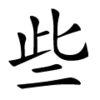些
| ||||||||
Translingual
| Stroke order | |||
|---|---|---|---|
 | |||
Han character
些 (Kangxi radical 7, 二+6, 8 strokes, cangjie input 卜心一一 (YPMM), four-corner 21101, composition ⿱此二)
Derived characters
- 㾚 𠉃 𣒄 𢧲 𨧥 𭈐
References
- KangXi: page 87, character 10
- Dai Kanwa Jiten: character 268
- Dae Jaweon: page 183, character 16
- Hanyu Da Zidian (first edition): volume 2, page 1441, character 8
- Unihan data for U+4E9B
Chinese
| trad. | 些 | |
|---|---|---|
| simp. # | 些 | |
| alternative forms | 㱔 | |
Glyph origin
| Historical forms of the character 些 | |
|---|---|
| Shuowen Jiezi (compiled in Han) | |
| Small seal script | |
 | |
| |
|
References: Mostly from Richard Sears' Chinese Etymology site (authorisation),
|
Characters in the same phonetic series (此) (Zhengzhang, 2003)
| Old Chinese | |
|---|---|
| 些 | *saːls, *sjaːl, *seːs |
| 跐 | *ʔsreːʔ, *ʔseʔ, *sʰeʔ, *ʔsreʔ |
| 柴 | *zreː |
| 祡 | *zreː |
| 茈 | *zreː, *ʔseʔ, *ze |
| 眦 | *zreːs |
| 砦 | *zraːds |
| 寨 | *zraːds, *slɯːɡ |
| 啙 | *ʔseː, *zeːʔ, *ʔseʔ |
| 泚 | *sʰeːʔ, *sʰeʔ |
| 玼 | *sʰeːʔ, *sʰeʔ, *ze |
| 皉 | *sʰeːʔ |
| 鮆 | *zeːʔ, *ʔse |
| 眥 | *zeːs, *zes |
| 貲 | *ʔse |
| 髭 | *ʔse |
| 頾 | *ʔse |
| 訾 | *ʔse, *ʔseʔ |
| 鴜 | *ʔse, *ze |
| 鈭 | *ʔse, *sʰe |
| 姕 | *ʔse, *sʰe, *ze |
| 觜 | *ʔse, *ʔse, *ʔseʔ |
| 紫 | *ʔseʔ |
| 訿 | *ʔseʔ |
| 呰 | *ʔseʔ |
| 嘴 | *ʔseʔ |
| 雌 | *sʰe |
| 此 | *sʰeʔ |
| 佌 | *sʰeʔ, *seʔ |
| 庛 | *sʰes |
| 疵 | *ze |
| 骴 | *ze, *zes |
| 胔 | *ze, *zes |
| 飺 | *ze |
| 齜 | *ʔsre |
Etymology 1
(This etymology is missing or incomplete. Please add to it, or discuss it at the Etymology scriptorium.)
Pronunciation
Definitions
些
Synonyms
Dialectal synonyms of 些 (“some, a few”) [map]
| Variety | Location | Words |
|---|---|---|
| Formal (Written Standard Chinese) | 些 | |
| Mandarin | Taiwan | 些 |
| Singapore | 些 | |
| Cantonese | Guangzhou | 啲 |
| Hong Kong | 啲 | |
| Taishan | 尼 | |
| Singapore (Guangfu) | 啲 | |
| Hakka | Meixian | 兜 |
| Miaoli (N. Sixian) | 兜 | |
| Pingtung (Neipu; S. Sixian) | 兜 | |
| Hsinchu County (Zhudong; Hailu) | 兜 | |
| Taichung (Dongshi; Dabu) | 兜 | |
| Hsinchu County (Qionglin; Raoping) | 兜 | |
| Yunlin (Lunbei; Zhao'an) | 兜 | |
| Min Nan | Xiamen | 寡 |
| Zhangzhou | 寡 | |
| Tainan | 寡 | |
| Singapore (Hokkien) | 寡 | |
| Manila (Hokkien) | 寡 | |
| Shantou | 撮 | |
| Jieyang | 撮 | |
| Singapore (Teochew) | 撮 | |
| Wu | Wenzhou | 厘兒 |
Compounds
Etymology 2
(This etymology is missing or incomplete. Please add to it, or discuss it at the Etymology scriptorium.)
Pronunciation
Compounds
|
|
Etymology 3
(This etymology is missing or incomplete. Please add to it, or discuss it at the Etymology scriptorium. Particularly: “related to etymology 1?”)
Pronunciation
References
- Dictionary of Chinese Character Variants (教育部異體字字典), A00056
- 諸橋轍次 (Morohashi Tetsuji), chief ed. 大漢和辞典 (Dai Kan-Wa Jiten, “Comprehensive Chinese–Japanese Dictionary”). 13 vols. 1955–1960. Revised and enlarged ed. 1984–1986. Tokyo: Taishukan.
Japanese
Vietnamese
References
This article is issued from Wiktionary. The text is licensed under Creative Commons - Attribution - Sharealike. Additional terms may apply for the media files.
